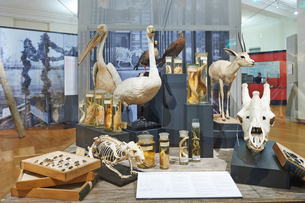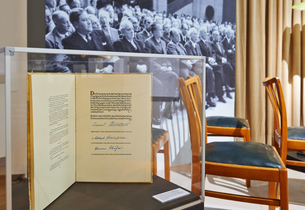
History of the Museum - From Groundbreaking to Today
The laying of the foundation stone of the main building was celebrated for the 100th time in 2012. The exhibition documents the exciting and eventful history of the research museum.
The present research museum owes its existence to the founder and zoologist Alexander Koenig. With the groundbreaking of the new museum building on 3 September 1912, the birthday of his wife Margarethe, a new chapter in the fascinating history of the founder began. A new and large natural history museum was to be built in Bonn to make room for the scientist's rapidly growing collections.
Alexander Koenig was the son of the Russian sugar producer Leopold Koenig, who then owned the Villa Hammerschmidt - today the official residence of the Federal President. But as the birthplace of the Federal Republic, the history of the museum itself is also closely linked to that of Germany: In the large atrium of the main building, under the beautiful glass roof, the opening session of the Parliamentary Council took place on 1 September 1948.
The exciting and eventful history is presented in the exhibition in the thematic areas of "Alexander Koenig's Research", "Architecture", "Confiscation", "Opening", "Nazi Period", "Post-War Period", "Museum of Fine Arts", "Personnel Development", "Collections" using original pieces from Alexander Koenig's time, large photographs and animations. For the first time, film clips from an expedition to Spitsbergen are shown, which provided the material and the inspiration for the construction of a particularly beautiful diorama (large showcase), which can still be seen in the permanent exhibition today.







